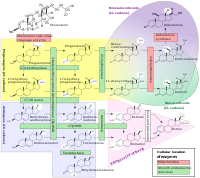Adrenal Hyperplasia, Congenital, Due To Steroid 11-Beta-Hydroxylase Deficiency

A number sign (#) is used with this entry because congenital adrenal hyperplasia (CAH) due to 11-beta-hydroxylase deficiency is caused by homozygous or compound heterozygous mutation in the CYP11B1 gene (610613) on chromosome 8q24.
DescriptionCongenital adrenal hyperplasia due to 11-beta-hydroxylase deficiency is an autosomal recessive disorder of corticosteroid biosynthesis resulting in androgen excess, virilization, and hypertension. The defect causes decreased synthesis of cortisol and corticosterone in the zona fasciculata of the adrenal gland, resulting in accumulation of the precursors 11-deoxycortisol and 11-deoxycorticosterone; the latter is a potent salt-retaining mineralocorticoid that leads to arterial hypertension (White et al., 1991).
CAH due to 11-beta-hydroxylase deficiency accounts for approximately 5 to 8% of all CAH cases; approximately 90% of cases are caused by 21-hydroxylase deficiency (201910) (White et al., 1991).
Clinical FeaturesThe nature of the defect in congenital adrenal hyperplasia associated with hypertension was first demonstrated by Eberlein and Bongiovanni (1956) on the basis of the accumulated steroids.
Glenthoj et al. (1980) diagnosed 11-beta-hydroxylase deficiency in 3 adult patients who had been thought to have 21-hydroxylase deficiency.
Rosler et al. (1982) reported 26 patients with CAH due to 11-beta-hydroxylase deficiency in 18 Jewish families from Morocco, Tunis, Turkey, and Iran. Parental consanguinity was found in 7 families. Patients had severe volume-induced hypertension with low levels of plasma renin activity. Affected females showed a wide range in the clinical expression of androgen excess, ranging from enlarged clitoris to penile urethra with fused labial-scrotal folds. Ten of 14 females were reared as males and diagnosis was often delayed until puberty when breasts developed and menses occurred. Signs of mineralocorticoid excess and degree of virilization were not correlated. Hypertension leading to fatal vascular accidents was observed in only mildly virilized patients, and complete pseudohermaphrodites were sometimes normotensive. Six patients had overt hypokalemia.
Hochberg et al. (1985) observed 15 affected girls and 9 affected boys, all Jewish individuals of Moroccan and Iranian extraction. Final height was severely compromised in all, regardless of age at diagnosis and quality of therapeutic control. Onset of puberty was precocious in males and normal in females. Gynecomastia, very unusual in male infants after 1 month, was present in 4 at diagnosis. All were being raised as males, although 2 were karyotypic females. Hydrocortisone acetate was superior to cortisone acetate or prednisone in promotion of growth.
Rosler et al. (1992) reviewed the characteristics of 38 persons with 11-beta-hydroxylase deficiency from 25 families over a 39-year period; 19 families came from Morocco, and in another 2 of the families one parent came from Morocco.
Helmberg et al. (1992) reported an 8-year-old boy of Turkish origin, born of consanguineous parents, with CAH due to 11-beta-hydroxylase deficiency. The patient had marked hypertension, precocious pseudopuberty, height and weight above the 97th percentile, epiphyseals already completely closed, and completely virilized intersexual genitalia (Prader type IV, penis with hypospadias, scrotum lacking palpable testes) with a 46,XX karyotype. Ultrasound examination disclosed adrenal hyperplasia and the existence of a uterus and vagina ending in the proximal urethra. Four sibs of the patient died shortly after birth or in early childhood.
Al-Jurayyan (1995) reported that 78 Saudi children with CAH were seen at a hospital in Riyadh over a 10-year period. Of these, 20 (25.6%) patients from 11 families had 11-beta-hydroxylase deficiency. Pseudoprecocious puberty in males and variable degrees of virilization in females led to wrong sex assignment in 7 (58.3%). Neonatal salt-wasting before treatment occurred in 3. Moderate to severe hypertension associated with hypokalemia was present in another 6. In 4 sibs, hypertension persisted despite adequate hydrocortisone therapy. Al-Jurayyan (1995) observed that the disorder appeared to be relatively frequent in the Saudi Arabian population.
Clark (2000) presented 2 patients with what she called 'nonclassic' or 'partial/mild' 11-beta-hydroxylase deficiency that differed by less frequent prenatal virilization and hypertension compared to the classic form. The first child was a 6-year-old boy referred for precocious puberty. He was tall (95th percentile) and had high-normal blood pressure (90th percentile for age) and Tanner III genitalia. Skeletal age was approximately twice chronologic age. The serum level of 11-deoxycortisol was elevated, as was the level of tetrahydro substance S, a metabolite. The second child was a 1-month-old girl with an enlarged clitoris but no labial fusion. She had normal blood pressure for age. Serum 11-deoxycortisol was markedly elevated.
DiagnosisPrenatal Diagnosis
Rosler et al. (1979) and Rosler et al. (1988) found that increased levels of tetrahydro-11-deoxycortisol in the amniotic fluid could be used for prenatal diagnosis of 11-beta-hydroxylase deficiency. The analysis of hormonal parameters was most reliable when sequential maternal urine and amniotic fluid determinations were performed in parallel.
Misdiagnosis as 21-Hydroxylase Deficiency
Tonetto-Fernandes et al. (2006) sought to identify possible misdiagnosed patients with 11-beta-hydroxylase deficiency among those with 21-hydroxylase deficiency. To recognize patients with 21- and/or 11-beta-hydroxylase deficiency, they recommended evaluation of 17-hydroxyprogesterone or 21-deoxycortisol (21DF) and 11-deoxycortisol (S). Also, 21DF may be useful to follow up pubertal patients with 21-hydroxylase deficiency. Their finding that 1% of Brazilian patients with alleged 21-hydroxylase deficiency may have 11-beta-hydroxylase deficiency led Tonetto-Fernandes et al. (2006) to infer that its frequency maybe underestimated.
Molecular GeneticsIn affected individuals of Moroccan Jewish ancestry with CAH due to steroid 11-beta-hydroxylase deficiency, White et al. (1991) identified a homozygous mutation in the CYP11B1 gene (R448H: 610613.0001). Most of the patients had previously been reported by Rosler et al. (1982).
Helmberg et al. (1992) identified a homozygous mutation in the CYP11B1 gene (610613.0005) in an 8-year-old boy of Turkish origin with CAH due to 11-beta-hydroxylase deficiency.
Geley et al. (1996) identified 7 mutations in the CYP11B1 gene in 9 patients with CAH due to 11-beta-hydroxylase deficiency. A Caucasian patient was homozygous for the R448H mutation previously found in Jews of Moroccan origin. All of the mutations resulted in a complete loss of steroid 11-beta-hydroxylating activity when expressed in cultured cells.
HistoryBrautbar et al. (1979) and New et al. (1981) excluded linkage of 11-beta-hydroxylase deficiency to the HLA locus (142800) on chromosome 6.